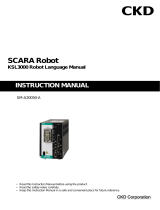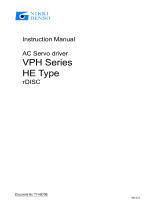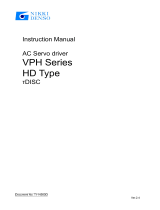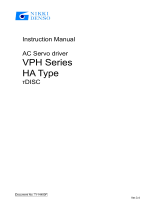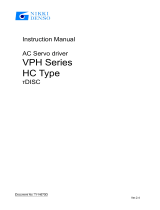Page is loading ...

SCARA Robot
KSL3000 Additional Function Manual
INSTRUCTION MANUAL
• Read this Instruction Manual before using the product.
• Read the safety notes carefully.
• Keep this Instruction Manual in a safe and convenient place for future reference.
SM-A20058-A
MSV-484083

-2-
SM-A20058-A
2020-08-18
KSL3000 Additional Function Manual
This document explains additional functions of CKD Corporation industrial robot
controller KSL3000.
Chapter 1
Explains NCBOY additional axis function.
Chapter 2
Explains the pulse output function.
Chapter 3
Explains the area output function.
The information contained in this manual is subject to change without notice.
The respective manuals of Safety, Operation, Robot Language, Interface, Installation
and Transportation, Communication, User Parameters, and Alarms are available. Use
this manual in combination with the other manuals as appropriate.

-3-
SM-A20058-A
2020-08-18
KSL3000 Additional Function Manual
Table of Contents
Chapter 1 NCBOY Additional Axis Function ............................................................... 4
Chapter 2 Pulse Output Function ................................................................................ 5
........................................................................................................................................ 5
Chapter 3 Area Output Function .................................................................................. 6
3.1 Overview of the area output function ................................................................ 6
3.2 Parameters....................................................................................................... 6
3.3 Usage Example ................................................................................................ 9
3.3.1 Case where the same DOUT number is used on more than one table........ 11

-4-
SM-A20058-A
2020-08-18
KSL3000 Additional Function Manual
Chapter 1
NCBOY Additional Axis Function
Cannot be used with SCARA system.

-5-
SM-A20058-A
2020-08-18
KSL3000 Additional Function Manual
Chapter 2
Pulse Output Function
Not available with robot controller KSL3000.

-6-
SM-A20058-A
2020-08-18
KSL3000 Additional Function Manual
Chapter 3
Area Output Function
This chapter explains the area output function.
3.1 Overview of the area output function
The area output function is a function for turning on or off a specified DOUT signal
when the robot enters a specified area. It allows you to choose 64 combinations of a
specified area and a specified DOUT signal.
The controller system versions in which this function is supported are as follows:
Main section: X8GCAS-13E or higher (SCARA)
3.2 Parameters
The setting parameters for the area output function are described in the “AREA.PAR”
parameter file. The parameter format is as follows:
[A00] AREA OUTPUT SETTING PARAMETER
{Area output flag (0:Disable 1:Enable)}
{P1:+Direction position coordinate [mm]}
{P2:-Direction position coordinate [mm]}
{Dout number}
{Table No.1}
= 0 Area output function enabling/disabling setting
= 9999.9 9999.9 9999.9 0.0 0.0 0.0 0.0 0.0
= -9999.9 -9999.9 -9999.9 0.0 0.0 0.0 0.0 0.0
Cuboid areas P1 and P2
= 1 Output DOUT number and output logic
{Table No.2}
= 0
= 9999.9 9999.9 9999.9 0.0 0.0 0.0 0.0 0.0
= -9999.9 -9999.9 -9999.9 0.0 0.0 0.0 0.0 0.0
= 2
{Table No.3}
= 0
= 9999.9 9999.9 9999.9 0.0 0.0 0.0 0.0 0.0
= -9999.9 -9999.9 -9999.9 0.0 0.0 0.0 0.0 0.0
= 3
{Table No.64}
= 0
= 9999.9 9999.9 9999.9 0.0 0.0 0.0 0.0 0.0
= -9999.9 -9999.9 -9999.9 0.0 0.0 0.0 0.0 0.0
= 64

-7-
SM-A20058-A
2020-08-18
KSL3000 Additional Function Manual
Area output function enabling/disabling setting
This parameter specifies whether to enable or disable the area output function.
0: Disables the function
1: Enables the function
Data type: Integer type
Data range: 0 or 1
Value example: 0
Cuboid areas P1 and P2
These parameters specify an area for which a signal is output. When the robot
enters the specified cuboid area, the specified DOUT signal is turned on or off.
* If the values of (plus position) and (minus position) are interchanged, this does
not affect operation.
Setting: = (plus position x-coordinate), (plus position y-coordinate),
(plus position z coordinate), (reserved), (reserved),
(reserved), (reserved), (reserved)
= (minus position x-coordinate), (minus position y-coordinate),
(minus position z coordinate), (reserved), (reserved),
(reserved), (reserved), (reserved)
Data type: Real number type
Data unit: mm
Data range: -9999.9 to 9999.9
Value example: 1.0
Z
Y
Plus position
Minus position
X

-8-
SM-A20058-A
2020-08-18
KSL3000 Additional Function Manual
Output DOUT number and output logic
This parameter specifies the DOUT number for which a signal is output.
If the DOUT number is positive, the specified DOUT is turned on when the robot
enters the specified area. Also, if the DOUT number is negative, the specified
DOUT is turned off when the robot enters the specified area.
Data type: Integer type
Data range: 1 to 64, -1 to -64, 101 to 164, -101 to -164, 301 to 364, -301 to
-364, 401 to 464, -401 to -464
Value example: 1
Note:
• If the same DOUT number is specified on more than one table, the output signal
will be the logical OR of the DOUT output of each table. Details are provided in the
next section.
• Note that a specified DOUT enabled by this function cannot be turned on or off by
using the SCOL language or a teaching pendant.

-9-
SM-A20058-A
2020-08-18
KSL3000 Additional Function Manual
3.3 Usage Example
This section gives an example where AREA.PAR is written as follows:
The area specified in Table No.1 is as shown in the figure below.
If the current position of the robot is within the specified area, DOUT (1) is turned on;
otherwise, DOUT (1) is turned off.
[A00] AREA OUTPUT SETTING PARAMETER
{Area output flag (0:Disable 1:Enable)}
{P1:+Direction position coordinate [mm]}
{P2:-Direction position coordinate [mm]}
{Dout number}
{Table No.1}
= 1
= 700.0 100.0 200.0 0.0 0.0 0.0 0.0 0.0
= 400.0 -200.0 0.0 0.0 0.0 0.0 0.0 0.0
= 1
{Table No.2}
= 1
= 650.0 250.0 200.0 0.0 0.0 0.0 0.0 0.0
= 350.0 -50.0 0.0 0.0 0.0 0.0 0.0 0.0
= -2
Within the specified area
DOUT (1) ON
Outside the specified area
DOUT (1) OFF

-10-
SM-A20058-A
2020-08-18
KSL3000 Additional Function Manual
The area specified in Table No.2 is as shown in the figure below.
If the current position of the robot is within the specified area, DOUT (2) is turned off;
otherwise, DOUT (2) is turned on.
Within the specified area
DOUT (2) OFF
Outside the specified area
DOUT (2) ON

-11-
SM-A20058-A
2020-08-18
KSL3000 Additional Function Manual
3.3.1 Case where the same DOUT number is used on more than one table
If this area output function is used to specify the same DOUT number on more than
one table, the output signal will be the logical OR of the DOUT output of each table.
In other words, if output ON and OFF instructions are given at the same time, the ON
instruction will be given priority.
Here is an example where AREA.PAR is written as follows:
The specified areas are as shown below.
Area
Area
Area
Area
[A00] AREA OUTPUT SETTING PARAMETER
{Area output flag (0:Disable 1:Enable)}
{P1:+Direction position coordinate [mm]}
{P2:-Direction position coordinate [mm]}
{Dout number}
{Table No.1}
= 1
= 700.0 100.0 200.0 0.0 0.0 0.0 0.0 0.0
= 400.0 -200.0 0.0 0.0 0.0 0.0 0.0 0.0
= 1
{Table No.2}
= 1
= 650.0 250.0 200.0 0.0 0.0 0.0 0.0 0.0
= 350.0 -50.0 0.0 0.0 0.0 0.0 0.0 0.0
= -1

-12.-
KSL3000 Additional Function Manual
2020-08-18
SM-A20058-A
Also, the areas are divided into the following four areas depending on the
combination of the setting values of each table.
ON/OFF of DOUT (1) in each area is as follows:
Area : Table No.1 is ON, Table No.2 is OFF, and DOUT (1) is ON.
Area : Table No.1 is ON, Table No.2 is ON, and DOUT (1) is ON.
Area : Table No.1 is OFF, Table No.2 is OFF, and DOUT (1) is OFF.
Area : Table No.1 is OFF, Table No.2 is ON, and DOUT (1) is ON.
Area
Area
Area
Area
Area specified
on Table No.1
Area
specified on
Table No.2
1/12

